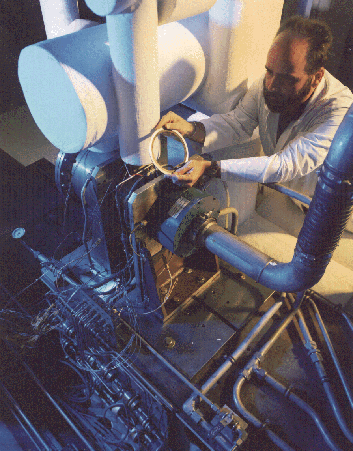 |
|||||
| Home | Research | For Teachers | HISTORY Level 1 Level 2 Level 3 |
PRINCIPLES Level 1 Level 2 Level 3 |
CAREER Level 1 Level 2 Level 3 |
| Gallery | Hot Links | What's New! | |||
| Web Administration and Tools | |||||
 |
|||||
| Home | Research | For Teachers | HISTORY Level 1 Level 2 Level 3 |
PRINCIPLES Level 1 Level 2 Level 3 |
CAREER Level 1 Level 2 Level 3 |
| Gallery | Hot Links | What's New! | |||
| Web Administration and Tools | |||||
![]()
The Army/NASA Lewis joint seals program is nationally recognized for making contributions to turbine engine seal development. Seal research is aimed at improving the performance, life, and reliability of seals to meet ever-more demanding engine operational requirements.
Through joint Army/NASA sponsorship, a path-finding study was conducted by Allison Engine Company to assess the system level benefits of improved seals for both an advanced IHPTET-class turboshaft engine suitable for light helicopter applications (e.g., AH-64 Apache) and for an Advanced Subsonic Technology (NASA-AST) regional turbofan engine powering a 150-170 passenger airliner. This study identified the key areas required for seal development over the next 5-10 years to meet the goals of the DoD-IHPTET and NASA-AST programs Seal needs identified ranged from durable, heat resistant brush seals to low-leakage, long-life film riding seals through active tip clearance control, amongst several others. The study demonstrated that implementing fewer than 10 advanced seals in various locations would result in savings of 5% in specific fuel consumption (SFC) or up to 50% increase in range (IHPTET).
The study is serving as a significant guide for the NASA/Army team, Allison, and seal vendors alike, as the seal community undertakes development programs to meet demanding future missions.
In collaboration with GE-Lynn, Army/NASA performed T-700 engine tests substituting a brush seal in place of the labyrinth compressor discharge seal. These tests demonstrated a significant 1% increase in specific fuel savings, through reduced parasitic losses and increased cycle pressures.
Shaft seal development tests continue in the high temperature (1100°F) brush seal rig installed at NASA Lewis. Cooperative tests have been run with William's International, Allied Signal, Cross Mfg., and Technetics. Also, the first known tests of ceramic brush seals with potential for 1500°F operation were tested in this unique seal rig. Plans are to upgrade the rig to evaluate seal performance at temperatures up to 1500°F under simulated life cycling, and to continue to examine advanced designs and material systems to meet future seal challenges.
POC: George Bobula

Seals Rig
![]()
Send all comments to ![]() aeromaster@eng.fiu.edu
aeromaster@eng.fiu.edu
© 1995-98 ALLSTAR Network. All rights reserved worldwide.
Updated: February 17, 1999